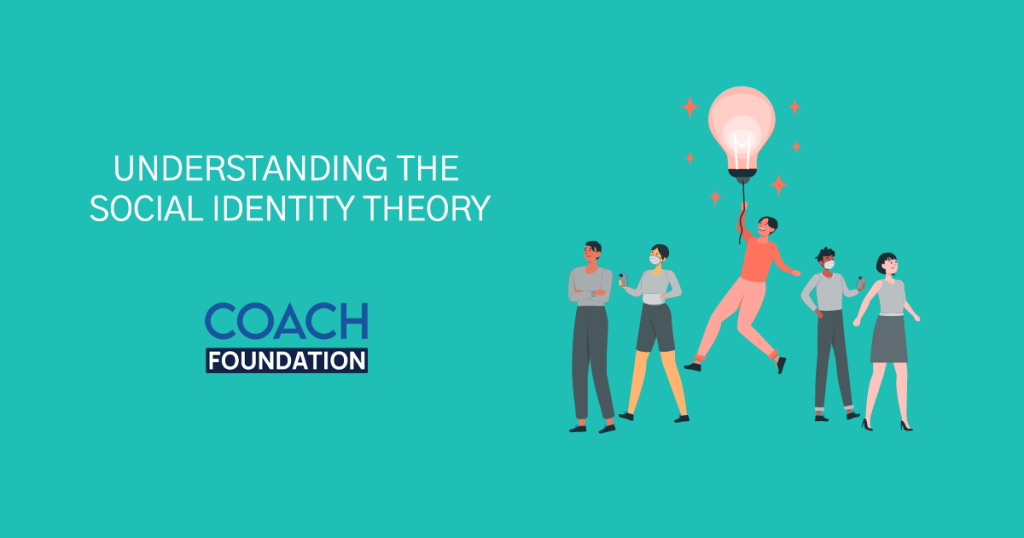Blog » Coaching Models and Techniques » Understanding The Social Identity Theory
Understanding The Social Identity Theory
Social Identity Theory is a psychological theory that explains how we develop our sense of self through our group memberships. It suggests that we categorize ourselves and others into different social groups based on shared characteristics such as age, gender, ethnicity, religion, and nationality.

We then use these group memberships to form our social identity, which influences how we perceive and interact with others. By understanding the Social Identity Theory, we can gain insights into how people’s group identities shape their beliefs, attitudes, and behaviors, and how these dynamics can lead to intergroup conflicts and discrimination.
In this blog, we’ll explore:
1. What is the social identity theory
2. How the social identity theory works
3. Core Concepts of social identity theory
4. Application of social identity theory in life coaching
So, let’s dive deeper into social identity theory and explore its key concepts and implications.
What is the Social Identity theory
Social Identity Theory is a psychological theory that explains how people develop their sense of self and their behavior through their group memberships.
Henri Tajfel and John Turner first proposed the theory in the 1970s, and since then, it has received extensive research and application in a variety of fields, including sociology, anthropology, and organizational behavior. It suggests that individuals categorize themselves and others into social groups based on shared characteristics such as race, ethnicity, gender, religion, and nationality.
These group memberships then become part of an individual’s social identity, which affects their perceptions, attitudes, and behaviors towards members of their own group and other groups. According to the theory, individuals strive to maintain a positive social identity by enhancing the status of their own group and derogating the outgroup. This can lead to intergroup conflicts and discrimination.
The Social Identity Theory posits that individuals can have multiple identities and that the salience of a particular identity can change depending on the social context. For example, a person’s identity as a parent may become more salient in a parent-teacher conference, while their identity as a fan of a sports team may be more salient in a sports bar.
Furthermore, the theory suggests that individuals can change their group memberships and social identities over time and that the process of socialization and interaction with others can influence these changes. For example, someone who moves to a new country may develop a new social identity based on their nationality and cultural background.
Check out this video to decipher more about the Social Identity Theory: The science of ‘us’ vs ‘them’!
How the social identity theory works
The Social Identity Theory suggests that individuals categorize themselves and others into social groups based on shared characteristics, such as race, gender, ethnicity, religion, and nationality. These group memberships become part of an individual’s social identity, which influences their perceptions, attitudes, and behaviors towards members of their own group and other groups.
For instance, consider a high school where there are different cliques, such as the popular kids, the jocks, the nerds, and the goths. Students may identify themselves with one or more of these groups, and their group membership becomes part of their social identity. They may have positive feelings towards members of their own group and negative feelings towards members of other groups.
The Social Identity Theory suggests that individuals strive to maintain a positive social identity by enhancing the status of their own group and derogating the out-group. This can lead to intergroup conflicts and discrimination. For example, members of the popular group may look down on the nerds and make fun of them, while the nerds may view the popular group as shallow and superficial.
However, the theory also suggests that positive intergroup contact can help reduce prejudice and discrimination. For example, if members of different cliques are brought together to work on a project or participate in a team sport, they may start to see each other as individuals rather than members of a particular group. This can lead to more positive attitudes and behaviors toward members of other groups.
Overall, the Social Identity Theory provides a framework for understanding how group memberships influence our behavior and interactions with others, and how positive intergroup contact can help reduce prejudice and discrimination.
I went through this comprehensive article explaining the impact of social identity theory on behavior, and I would suggest the readers go through it once as well!
Core Concepts of social identity theory
The core concepts of Social Identity Theory include the categorization of individuals into social groups based on shared characteristics, the formation of social identity through group memberships, and the salience of a particular identity depending on the social context.
The theory suggests that individuals strive to maintain a positive social identity by enhancing their own group’s status and derogating the out-group. Positive intergroup contact can reduce prejudice and discrimination, and socialization and interaction with others can influence changes in group membership and social identities. Below are a few core concepts of social identity theory.
Infer about the core concept of social identity theory through this article!
Social categorization
Social categorization is a core concept of Social Identity Theory. It refers to the process by which individuals classify themselves and others into social groups based on shared characteristics such as race, ethnicity, gender, religion, and nationality. Social categorization allows individuals to simplify the complex social world by organizing them into meaningful groups.
However, it can also lead to intergroup biases and discrimination, where individuals favor members of their own group and derogate members of other groups. Understanding the process of social categorization is essential to understanding how individuals form their group identities and how these identities influence their behavior and interactions with others.
Social identity
Social identity refers to an individual’s self-concept based on their group memberships. Social identity influences how individuals perceive themselves and others, their attitudes towards their own group and other groups, and their behavior towards members of their own and other groups.
Social identity can be influenced by various factors, including the salience of a particular identity in a given context, socialization and interaction with others, and the comparison of their group’s status to that of other groups. Understanding the role of social identity in intergroup relations is crucial for understanding prejudice, discrimination, and conflict between groups.
Social comparison
Social comparison refers to the process by which individuals evaluate their own group’s status by comparing it to that of other groups. Social comparison plays a critical role in maintaining a positive social identity by enhancing the status of the in-group and derogating the out-group. This can lead to intergroup biases and discrimination, where individuals favor members of their own group and derogate members of other groups.
The salience of a particular identity, the perceived relevance of the comparison group, and the characteristics of the comparison group can all have an impact on social comparison. Understanding the process of social comparison is essential for understanding how individuals maintain and enhance their social identity.
In-group bias
In-group bias refers to the tendency for individuals to favor members of their own group over members of other groups. In-group bias is an important mechanism for maintaining a positive social identity by enhancing the status of the in-group and derogating the out-group. In-group bias can manifest itself in various forms, including more favorable evaluations of in-group members, greater willingness to cooperate with in-group members, and greater hostility towards out-group members.
In-group bias can be influenced by various factors, including the perceived similarity between in-group and out-group members, the perceived threat posed by the out-group, and the perceived legitimacy of intergroup competition. Therefore, understanding the nature and consequences of in-group bias is important for promoting positive intergroup relations and reducing prejudice and discrimination.
Out-group derogation
Out-group derogation is another core concept of Social Identity Theory. It refers to the tendency for individuals to derogate from members of other groups. Out-group derogation is an important mechanism for maintaining a positive social identity by enhancing the status of the in-group and devaluing the out-group.
Out-group derogation can take various forms, including negative evaluations of out-group members, hostile behavior towards out-group members, and the endorsement of negative stereotypes about the out-group. Intergroup rivalry, the perceived threat the outgroup poses, and the perceived legitimacy of intergroup conflict are just a few factors that can affect out-group derogation.
Applying Social Identity Theory to Life Coaching
Social Identity Theory has important implications for life coaching, as it can provide insight into how individuals perceive themselves and others. Life coaches can use social identity theory to help their clients understand the importance of their group identities and how they influence their behavior and interactions with others.
For example, a life coach may work with a client who is struggling with low self-esteem due to their membership in a stigmatized group, such as a racial minority or a person with a disability. The life coach could use social identity theory to help the client understand the importance of their group identity and how it can provide a sense of belonging and social support. The life coach could also help the client develop strategies for coping with discrimination and managing the negative emotions associated with their group identity.
Another example could be a life coach working with a client who is experiencing conflict in a workplace with a diverse workforce. The life coach could use social identity theory to help the client understand the role of social categorization and social comparison in intergroup relations. The life coach could help the client recognize the biases and assumptions they may have about members of other groups and work with them to develop strategies for promoting positive intergroup relations.
Overall, applying social identity theory to life coaching can help clients better understand themselves and their interactions with others, ultimately leading to a more positive and fulfilling life experience.
Conclusion
To sum up, social identity theory is a framework for understanding how individuals form and maintain their identities based on their group memberships. The theory highlights the importance of social categorization, social comparison, in-group bias, and out-group derogation in shaping intergroup relations and influencing individual behavior.
Understanding social identity theory can help individuals and professionals, such as life coaches, better understand the complex dynamics of intergroup relations and work towards reducing prejudice, discrimination, and conflict between groups. By recognizing the power of group identities and the role they play in shaping individual behavior, we can work towards building more inclusive and equitable communities.
I am eager to receive your thoughts on this captivating blog and would appreciate it if you could share any additional insights or perspectives you may have in the comments section below.
Frequently Asked Questions (FAQs)
What is the concept of social identity theory?
Social Identity Theory is a social psychological theory that explains how individuals develop and maintain their sense of identity based on their group membership. It suggests that people categorize themselves and others into different groups based on various social identities, and these social identities serve as a way for individuals to understand themselves and others in the social world.
Examples of social identity theory
Here are some examples of Social Identity Theory in action:
A sports fan identifies strongly with their favorite team and feels a sense of pride and belongingness when their team wins.
A person who identifies strongly with their ethnicity and feels a sense of connection and solidarity with other people of the same ethnicity.
A person who identifies strongly with their profession and feels a sense of pride and status associated with their job title.
Who founded social identity theory?
Social Identity Theory was first proposed by British social psychologists Henri Tajfel and John Turner in the 1970s. They developed this theory based on their research on intergroup relations and the psychological processes that occur when individuals categorize themselves and others into different groups.

ABOUT SAI BLACKBYRN
I’m Sai Blackbyrn, better known as “The Coach’s Mentor.” I help Coaches like you establish their business online. My system is simple: close more clients at higher fees. You can take advantage of technology, and use it as a catalyst to grow your coaching business in a matter of weeks; not months, not years. It’s easier than you think.
AS SEEN ON





